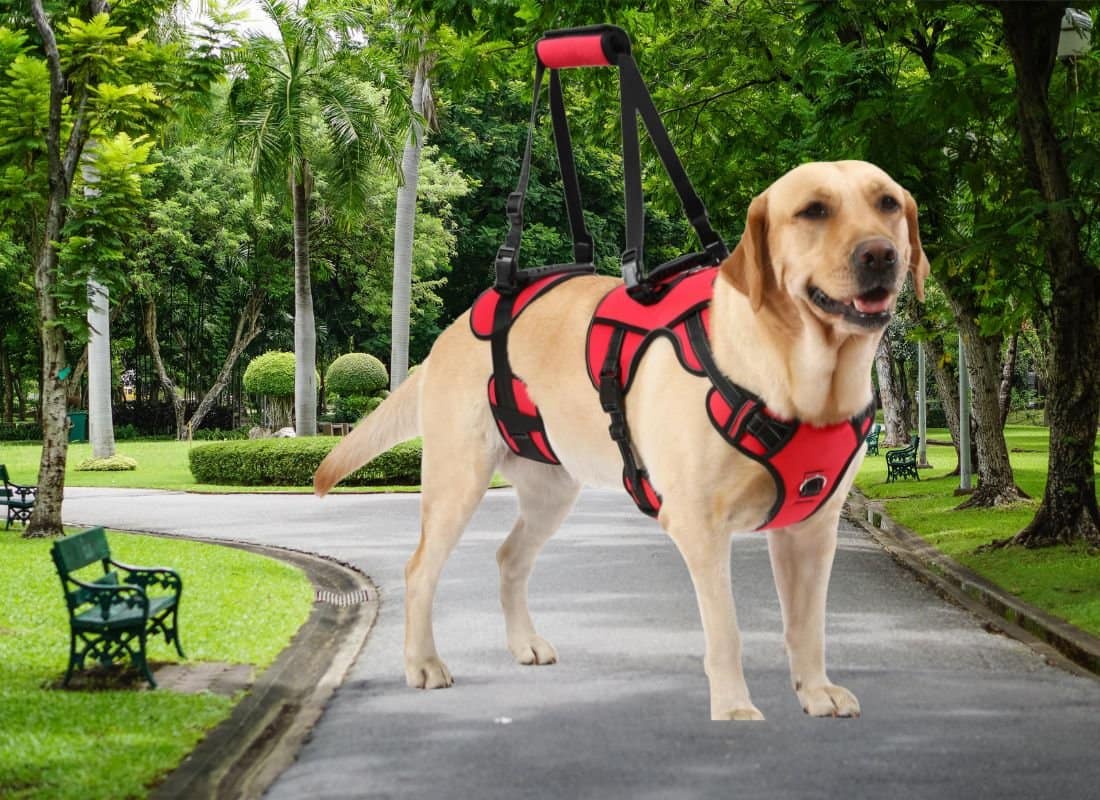Sudden Hind-Leg Weakness in Dogs: Understanding and Natural Treatment Options

What is Sudden Hind-Leg Weakness?
Sudden hind-leg weakness, also known as posterior paresis, occurs when a dog unexpectedly loses strength or control in their back legs. This condition can range from mild wobbling to complete inability to stand and can be quite distressing for both dogs and their owners.
Common Causes
Several factors can contribute to sudden hind-leg weakness:
1 – Age-Related Issues
Senior dogs commonly experience hind-leg weakness due to degenerative conditions like arthritis or intervertebral disk disease (IVDD). The natural aging process can affect joint health and nerve function.
2 – Injury or Trauma
Sprains, strains, or injuries to the spine, hips, or legs can cause sudden weakness. Even minor trauma can affect a dog’s mobility, especially in older or overweight dogs.
3 – Neurological Conditions
Conditions affecting the nervous system, such as degenerative myelopathy or fibrocartilaginous embolism (FCE), can lead to sudden leg weakness. These conditions require veterinary diagnosis and care.
Natural Treatment Approaches
While veterinary care is essential for proper diagnosis, several natural approaches can support recovery and management:
Full body harnesses help dogs with mobility issues in several key ways:
Types of Support Harnesses:
- Full-body lifting harnesses: Support both front and back ends
- Rear-support harnesses: Focus on hind legs
- Walking harnesses: Provide stability during movement
Benefits:
- Distribute weight evenly across the body
- Prevent strain on weak joints
- Allow caregivers to assist with standing and walking
- Enable bathroom assistance without direct lifting
- Provide stability on stairs or slippery surfaces
Key Features to Look For:
- Padded straps for comfort
- Adjustable fit
- Handle placement for effective lifting
- Machine washable material
- Quick-release buckles
- Breathable fabric
Proper Fitting:
- Measure chest, belly, and hip circumference
- Ensure straps don’t rub against sensitive areas
- Allow two fingers’ width between harness and body
- Check for pressure points during use
Tips for Use:
- Introduce gradually
- Use treats for positive association
- Check fit regularly as dog’s condition changes
- Clean regularly to prevent skin irritation
- Remove when not actively assisting
Physical Therapy Exercises
Gentle exercises can help maintain muscle strength and joint flexibility:
- Swimming in warm water (hydrotherapy)
- Passive range of motion exercises
- Controlled walking on soft surfaces
- Balance exercises on firm, non-slip surfaces
Massage and Acupressure
Regular massage can improve circulation and reduce muscle tension. Focus on:
- Gentle kneading of thigh muscles
- Circular motions around hip joints
- Light stroking along the spine
- Targeting specific acupressure points known to support nerve and muscle function
Dietary Support
Proper nutrition plays a crucial role in managing hind-leg weakness:
- Omega-3 fatty acids from fish oil for inflammation reduction
- Glucosamine and chondroitin supplements for joint health
- Vitamin C and E for tissue repair
- Adequate protein for muscle maintenance
Environmental Modifications
Creating a supportive environment helps prevent further injury:
- Non-slip mats on floors
- Ramps instead of stairs
- Orthopedic bedding
- Support harnesses for assistance with movement
Natural Supplements
Several natural supplements may help support mobility:
- Turmeric for its anti-inflammatory properties
- MSM (Methylsulfonylmethane) for joint support
- Green-lipped mussel extract
- Devil’s claw for pain management
When to Seek Veterinary Care
While natural treatments can be beneficial, certain signs warrant immediate veterinary attention:
- Complete loss of mobility
- Signs of pain or distress
- Loss of bladder or bowel control
- Progressive worsening of symptoms
- Accompanying neurological symptoms
Prevention Strategies
Preventing hind-leg weakness involves:
- Maintaining a healthy weight
- Regular, appropriate exercise
- Joint-supporting nutrition throughout life
- Regular veterinary check-ups
- Early intervention when problems arise
Long-term Management
Managing hind-leg weakness often requires a comprehensive approach:
- Consistent exercise routine
- Regular massage sessions
- Ongoing dietary support
- Environmental adaptations
- Monitor progress and adjust treatment as needed
Summary
While sudden hind-leg weakness can be concerning, many natural treatment options can help manage the condition and improve quality of life. However, these should complement, not replace, proper veterinary care. A combination of natural treatments, environmental modifications, and appropriate medical care often provides the best outcomes for affected dogs.
Remember that each dog’s situation is unique, and treatment plans should be tailored to individual needs and underlying causes. Always consult with a veterinarian before starting any new treatment regimen, even natural ones, to ensure safety and appropriateness for your dog’s specific condition.
Leave a Reply
You must be logged in to post a comment.
Leave a Comment